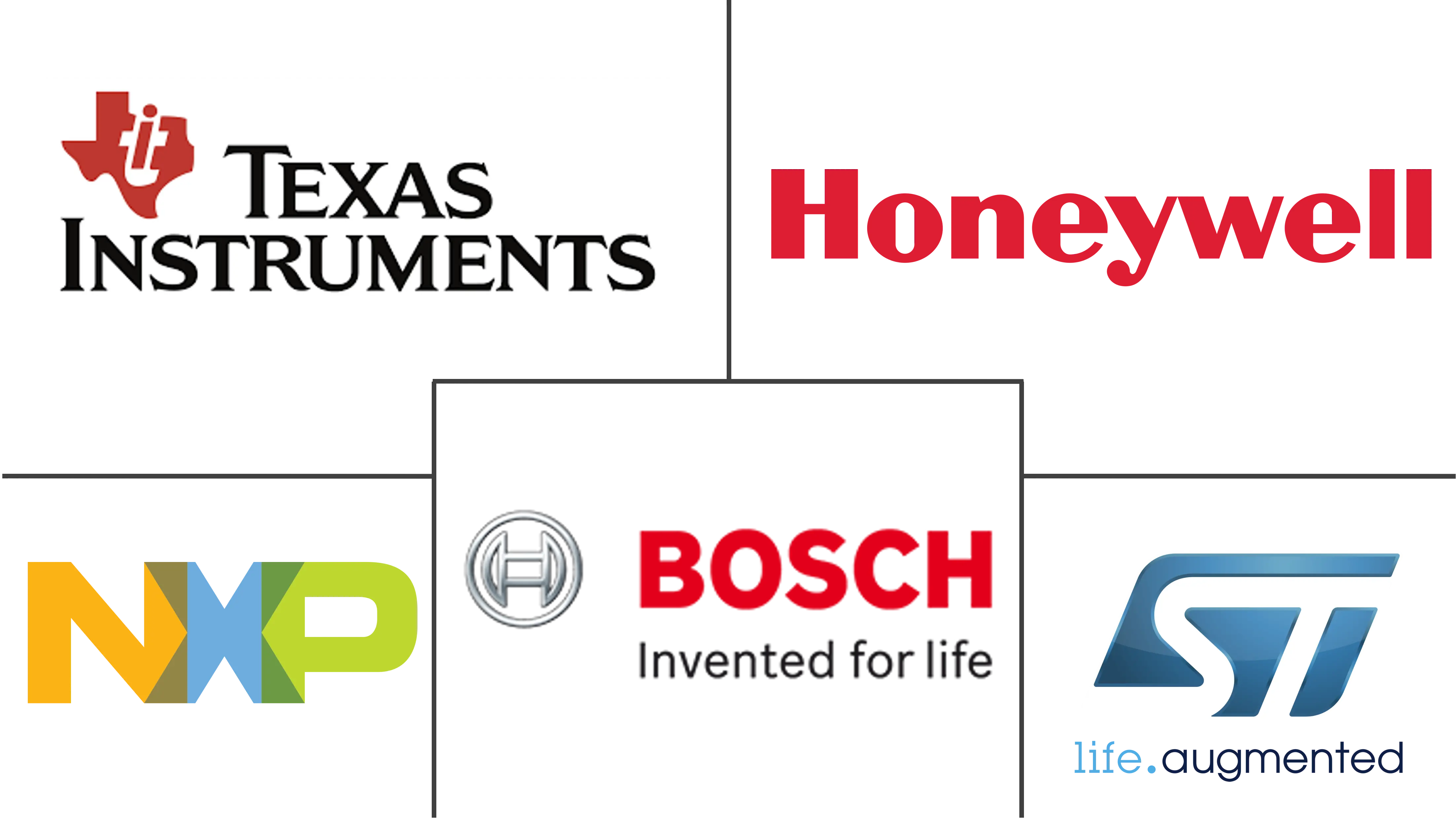IoT Sensor Market Size and Share
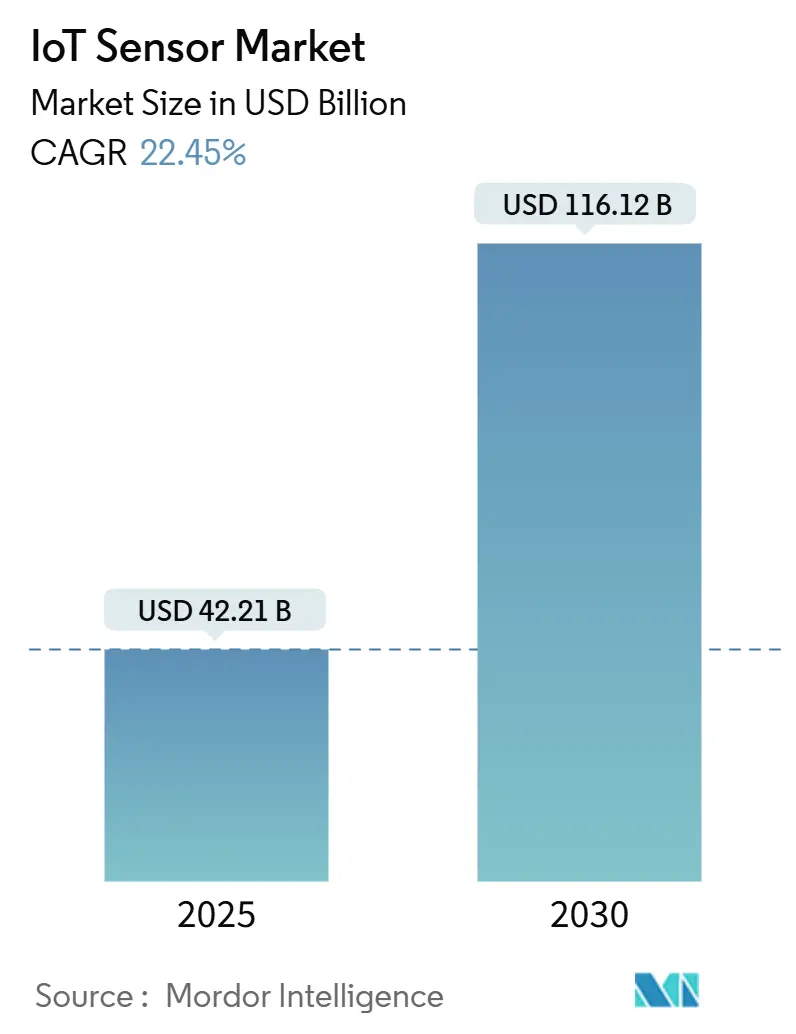
IoT Sensor Market Analysis by Mordor Intelligence
The IoT sensors market size is USD 42.21 billion in 2025 and is on track to reach USD 116.21 billion in 2030, reflecting a robust 22.45% CAGR. Steep demand accelerates as artificial intelligence and edge computing migrate into miniature sensing platforms across industrial automation, automotive safety, and urban infrastructure. Mandatory fleet-telematics rules in North America and India, private 5G deployments in Japanese factories, and battery-less energy-harvesting networks in Nordic offshore wind farms are widening adoption footprints. Competitive intensity is rising as semiconductor majors embed AI engines inside sensors to reduce latency and bandwidth. At the same time, low-power wide-area connectivity and energy harvesting are shifting total cost of ownership equations in remote monitoring scenarios.
Key Report Takeaways
- By sensor type, image sensors are advancing at a 28.4% CAGR and are set to overtake pressure sensors, which led with 18.2% of the IoT sensors market share in 2024.
- By technology, MEMS retained 42.7% of the IoT sensors market size in 2024; optical sensing is forecast to grow 26.1% annually to 2030.
- By connectivity, LoRaWAN and Sigfox protocols are expanding at a 32.8% CAGR, outpacing Wi-Fi’s 24.5% revenue share in 2024.
- By power source, battery solutions dominated 63% of the IoT sensors market size in 2024, while energy harvesting is climbing at 35.6% CAGR.
- By end-use industry, manufacturing held 21.9% revenue in 2024; smart city infrastructure is the fastest riser with a 30.2% CAGR through 2030.
- By region, Asia-Pacific captured 32.4% of 2024 revenue, underpinned by China’s smart-manufacturing policy support and Japan’s private 5G spectrum allocations.
Global IoT Sensor Market Trends and Insights
Drivers Impact Analysis
| DRIVER | (~) % IMPACT ON CAGR FORECAST | GEOGRAPHIC RELEVANCE | IMPACT TIMELINE |
|---|---|---|---|
| Rapid adoption of low-power MEMS-based multimodal sensors enabling edge analytics in European discrete manufacturing | +4.2% | Europe, with spillover to North America | Medium term (2-4 years) |
| Mandated fleet-telematics regulations in North America and India boosting automotive inertial/pressure sensor demand | +3.8% | North America & India, expanding to APAC | Short term (≤ 2 years) |
| Battery-less energy-harvesting sensor nodes for predictive maintenance in offshore wind farms (Nordics & UK) | +2.1% | Nordic countries & UK, extending to global offshore markets | Long term (≥ 4 years) |
| Private 5G networks in Japanese smart factories requiring time-synchronized image sensors | +3.5% | Japan, with adoption spreading to South Korea & China | Medium term (2-4 years) |
| Smart-water-meter rollouts by Middle-East desert utilities catalyzing ultrasonic‐flow sensor uptake | +1.9% | Middle East, expanding to arid regions globally | Medium term (2-4 years) |
| Rapid adoption of LoRaWAN/Sigfox LPWANs enabling scalable industrial IoT | +2.7% | Global industrial hubs | Short term (≤2 years) |
| Source: Mordor Intelligence | |||
Rapid adoption of low-power MEMS-based multimodal sensors enabling edge analytics in European discrete manufacturing
European manufacturers embed multimodal MEMS sensors directly in equipment to analyze vibration, temperature, sound, and pressure on-site. TDK’s i3 Micro Module integrates an AI core that predicts anomalies before breakdowns. Bosch Sensortec’s BHI360 family executes gesture and 3D-audio functions in under 600 µA, cutting network traffic 80% while retrofitting legacy lines. Predictive maintenance programs using these edge devices report 25% cost savings and extend asset life 20-30% across German and Italian plants.[1]James Blackman, “Toyota Material Handling Puts Entire US Factory on Ericsson Private 5G Network,” rcrwireless.com
Mandated fleet-telematics regulations in North America and India boosting automotive inertial/pressure sensor demand
The U.S. SmartWay modernization and India’s commercial-vehicle tracking rules oblige fleets to capture real-time vehicle data. Texas Instruments’ AWR1843AOP radar integrates DSP and MCU blocks to meet reporting and safety needs while supporting advanced driver assistance. Adoption is scaling as logistics firms shift to predictive maintenance scheduling, raising unit demand for multi-sensor arrays.[3] International Council on Clean Transportation, “Modernizing Data Collection for the SmartWay Program,” theicct.org
Battery-less energy-harvesting sensor nodes for predictive maintenance in offshore wind farms
Hybrid thermoelectric-piezoelectric harvesters from KIST increase on-board power 50%, allowing sensor grids on turbines where battery swaps are costly. MIT researchers harvest magnetic fields for perpetual operation of remote nodes. Operators avoid USD 50,000 per-turbine daily downtime and cut maintenance spending 15-20%.
Private 5G networks in Japanese smart factories requiring time-synchronized image sensors
Toyota Material Handling’s Ericsson 5G network illustrates the pivot from Wi-Fi to deterministic wireless for automation. Japan’s spectrum scheme supports sub-millisecond image-sensor sync for high-speed inspection. NICT trials show continuous “non-stop line” production via coordinated wireless control.
Restraints Impact Analysis
| RESTRAINTS | (~) % IMPACT ON CAGR FORECAST | GEOGRAPHIC RELEVANCE | IMPACT TIMELINE |
|---|---|---|---|
| 200mm MEMS-foundry capacity shortage limiting automotive-grade inertial sensor supply | -2.8% | Global, with acute impact in Asia-Pacific automotive hubs | Short term (≤ 2 years) |
| Calibration drift in long-lifecycle chemical sensors restricting pharma cold-chain adoption | -1.5% | Global pharmaceutical supply chains, concentrated in North America and Europe | Medium term (2-4 years) |
| Cyber-physical attack surface in wireless sensor networks delaying LatAm smart-grid projects | -1.2% | Latin America, with concerns spreading to emerging markets | Medium term (2-4 years) |
| Restricted access to critical materials (gallium, antimony) for sensor fabs | -1.0% | U.S., China, EU supply chains | Short term (≤2 years) |
| Source: Mordor Intelligence | |||
200mm MEMS-Foundry Capacity Shortage Limiting Automotive-Grade Inertial Sensor Supply
Global semiconductor manufacturing faces acute capacity constraints in 200mm MEMS foundries, creating supply bottlenecks for automotive-grade inertial sensors required for advanced driver assistance systems and autonomous vehicle development. SEMI reports indicate global semiconductor fab capacity expansion of 6% in 2024 and 7% in 2025, yet automotive sensor demand is growing at rates exceeding 25% annually, creating persistent supply-demand imbalances. The shortage particularly affects automotive inertial sensors requiring specialized packaging and extended temperature ranges, where qualification cycles can extend 18-24 months beyond standard consumer applications. X-FAB Silicon Foundries' USD 1 billion expansion targeting automotive and industrial applications represents industry efforts to address capacity constraints, though new fab capacity typically requires 2-3 years to reach full production.
Calibration drift in long-lifecycle chemical sensors restricting pharma cold-chain adoption
Chemical sensors deployed in pharmaceutical cold-chain applications experience calibration drift over extended operational periods, limiting their adoption in critical drug storage and transportation systems where measurement accuracy directly impacts product efficacy and patient safety. Research published in Frontiers in Chemistry identifies calibration drift as a primary challenge for electronic noses and tongues, with temporal validity limitations requiring frequent recalibration that increases operational costs and system complexity. The pharmaceutical industry's stringent regulatory requirements demand continuous measurement accuracy over sensor lifecycles that can extend 5-10 years, yet current chemical sensing technologies typically require recalibration every 6-12 months to maintain acceptable performance. Nuclear power plant research demonstrates that over 90% of sensors remain within calibration specifications during routine checks, suggesting that automated recalibration methods could address pharmaceutical applications while reducing operational costs.
Segment Analysis
By Sensor Type: Image sensors propel innovation
Image sensors drove a 28.4% CAGR and are forecast to eclipse pressure sensors’ 18.2 % contribution by 2030. The IoT sensors market size for image-based devices is widening as autonomous vehicles and AI-powered inspection systems migrate from prototypes to volume lines. Automotive OEMs integrate high-dynamic-range CMOS imagers with inertial units for sensor fusion, ensuring safe navigation in complex urban traffic. Industrial users deploy smart cameras that execute neural-network inference locally, eliminating bandwidth costs and protecting IP. Meanwhile, pressure sensors remain staples in pneumatics, HVAC, and process automation, sustaining steady demand. Across both categories, vendors embed micro-controllers and security enclaves to meet cybersecurity mandates in connected machinery.
A second wave of temperature, motion, and proximity sensors targets wearables and collaborative robots. Embedded AI routines recognise gestures and micro-movements, enriching user interfaces. Chemical and gas sensors confront calibration-drift hurdles, yet tightening air-quality rules and hydrogen-leak detection in fuel-cell vehicles preserve growth. Inertial and magnetic sensors underpin electric-vehicle motor control and precise positional feedback in industrial actuators, cementing their role within the IoT sensors market.
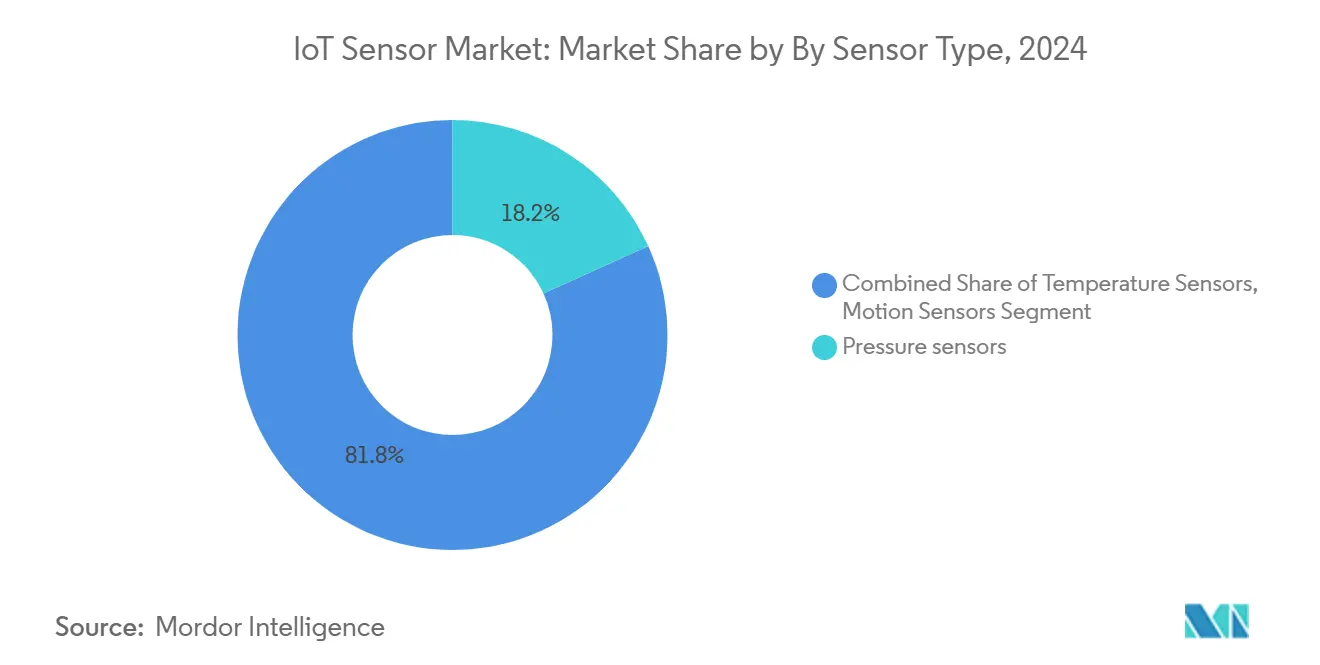
Note: Segment shares of all individual segments available upon report purchase
By Technology: MEMS dominance challenged by optical advances
MEMS retained 42.7% revenue in 2024, anchoring the IoT sensors market share through cost-effective wafer-level packaging. Yet optical techniques, led by LiDAR and structured-light systems, are growing 26.1% annually. MEMS foundries now co-package optical modulators and inertial elements, enabling hybrid modules that deliver ranging and orientation data from one socket. CMOS imagers saturate mature consumer segments but remain core to smartphone and dash-cam refresh cycles. Electrochemical sensors maintain footholds in point-of-care diagnostics. Piezoelectric harvesters re-emerge as designers tap vibration energy to power sub-milliwatt sensor clusters.[2]Francis Sedgemore, “Graphene Breakthrough as Bosch Creates Magnetic Sensor,” nanotech-now.com
Materials innovation is brisk: Infineon’s graphene-based Hall device achieves 100-times sensitivity over silicon peers, unlocking ultra-low field detection for robotics. Packaging advances combine glass-through-silicon vias with flip-chip to compress footprint while improving heat transfer, sustaining high reliability in automotive temperature extremes.
By Connectivity: LoRaWAN disrupts traditional paradigms
Wi-Fi held 24.5% revenue in 2024, yet LoRaWAN and Sigfox networks expand 32.8% each year as utilities and factories seek kilometer-scale coverage on coin-cell budgets. The IoT sensors market size for low-power wide-area devices is scaling as chipset costs drop below USD 2. Cellular NB-IoT and 5G RedCap address applications requiring guaranteed throughput and roaming, whereas Bluetooth LE caters to wearables. Hybrid architectures now embed dual radios, dynamically switching between LoRaWAN for telemetry and BLE for provisioning. LoRa Alliance membership surpassed 500 companies in 2024, reflecting ecosystem maturity .
By Power Source: Energy harvesting reshapes autonomy
Battery units still account for 63% of shipments, yet the IoT sensors market size for energy-harvesting designs is rising fast. Hybrid thermoelectric-vibration harvesters power condition-monitoring nodes that run for decades without maintenance. IEEE Spectrum documents magnetic-field harvesters that capture stray currents along cables, opening raw material processing plants to self-powered monitoring. Power-over-Ethernet and super-capacitor backups remain staples in data centers and building management where uninterrupted sensing is critical.
By End-Use Industry: Smart cities accelerate infrastructure overhaul
Manufacturing kept 21.9% of 2024 revenue as Industry 4.0 retrofits press ahead. In contrast, smart city infrastructure grows 30.2% annually, driven by intelligent street lighting, waste-collection optimization, and adaptive traffic controls. Fleet-telemetry rules boost automotive uptake, while healthcare invests in remote patient monitoring requiring FDA-grade reliability. Utilities deploy smart meters and grid-edge sensors to balance renewable inputs. Agriculture leverages soil-moisture probes and imagery to cut water usage. Logistics outfits embed environmental monitors in cold-chain parcels, guarding vaccine integrity.
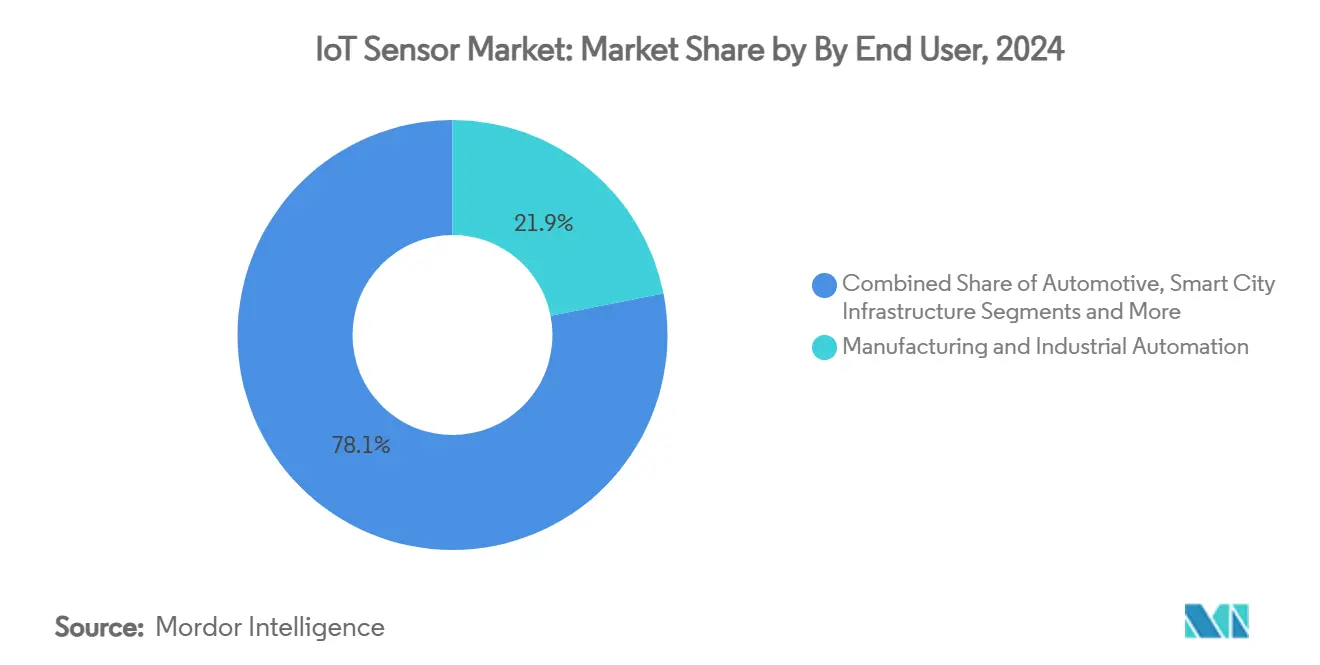
Note: Segment shares of all individual segments available upon report purchase
By Application: Predictive maintenance reshapes operations
Predictive-maintenance deployments demonstrate 25% maintenance savings and 70% downtime avoidance, energizing growth in heavy industries. Sensors feed machine-learning models that forecast bearing wear in rolling mills and detect cavitation in pumps. Structural health monitoring extends to bridges, tunnels, and wind turbines, with fiber-optic strain gauges and MEMS accelerometers delivering real-time integrity data. Human-machine interface advances move beyond buttons to gesture and voice control, elevating safety in hazardous environments. Ambient sensing optimizes HVAC energy use in commercial buildings.
Geography Analysis
Asia-Pacific led with 32.4% revenue in 2024. China’s “Industrial Internet Innovation and Development Action Plan” installs sensor grids for high-speed equipment coordination, while Japan’s private 5G allocations underwrite deterministic communication in smart factories. South Korea capitalizes on advanced semiconductor processes, anchoring supply security for regional OEMs. India mandates fleet telematics across commercial vehicles, rapidly scaling demand for inertial and environmental sensors. Australia’s mining sector requires rugged devices certified for explosive atmospheres, creating specialized niches within the IoT sensors market.
North America benefits from the CHIPS and Science Act. Texas Instruments secured USD 1.6 billion to build three 300 mm fabs, bolstering domestic sensor capacity. The region emphasizes cybersecurity, pushing suppliers to integrate secure-boot, encryption, and over-the-air update capabilities. Canada invests in environmental sensing to monitor forest-fire risk, while Mexico’s automotive clusters demand cost-competitive safety sensors.
Europe enforces strict emissions and safety standards. Germany’s discrete-manufacturing champions deploy AI-enabled MEMS modules to cut scrap rates. France invests in smart lighting and traffic management for carbon reduction. Nordic offshore wind farms cultivate energy-harvesting sensor deployments to manage turbine stress in sub-zero seas. The EU Cyber Resilience Act compels suppliers to certify software-driven sensors, increasing design complexity yet raising buyer confidence.
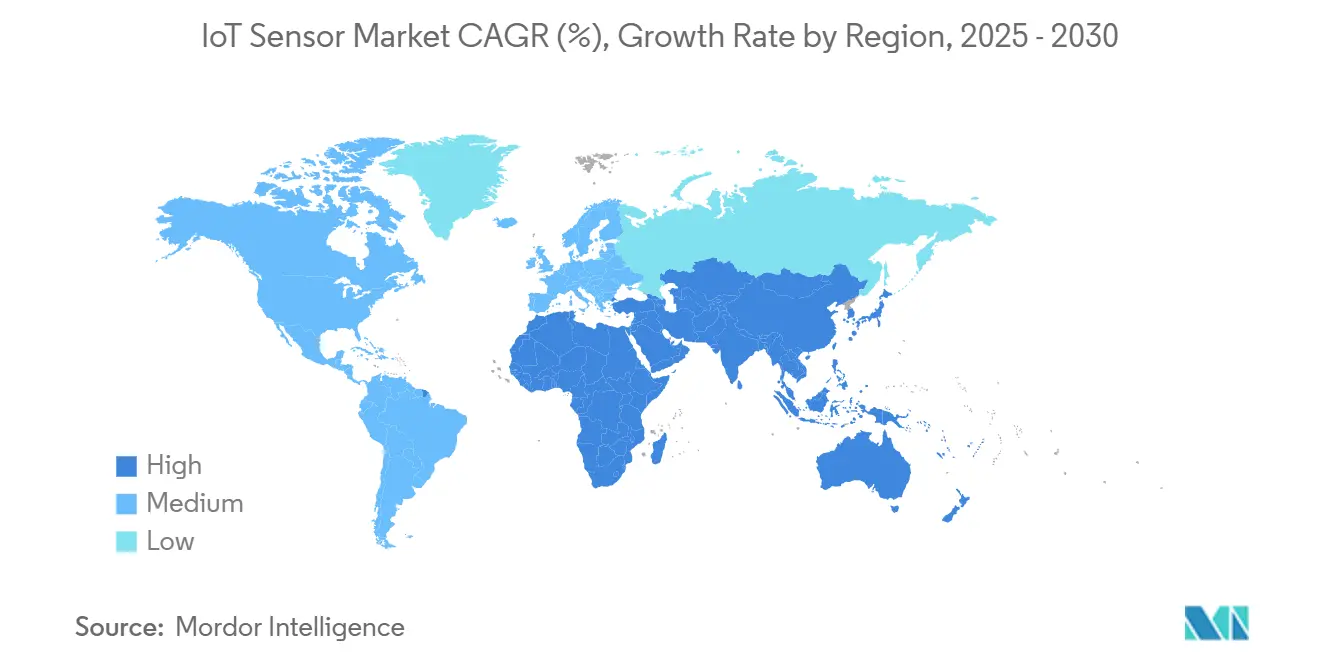
Note: Segment shares of all individual segments available upon report purchase
Competitive Landscape
The IoT sensors market remains moderately fragmented. Bosch Sensortec, Honeywell, and STMicroelectronics leverage sizable R&D budgets and global sales channels. Bosch plans to invest EUR 2.5 billion in AI development and targets 10 billion intelligent sensor shipments by 2030. Honeywell teams with Qualcomm on AI-powered industrial solutions and with NXP on aviation microcontrollers, sliding AI inference next to sensor front-ends. STMicroelectronics and Qualcomm co-develop turnkey Bluetooth/Wi-Fi modules for automotive infotainment.
White-space entrants focus on energy harvesting, cybersecurity, and novel materials. Infineon’s SURF unit merges sensor and RF teams to chase ambient IoT and green-energy markets. AMS-OSRAM ships the first AEC-Q102-qualified 8-channel LiDAR laser, expanding automotive perception options. Graphene‐based magnetic sensors from Bosch and Infineon promise dramatic performance gains over silicon. Strategic acquisitions, such as Honeywell’s purchase of Civitanavi Systems for autonomous navigation, underscore a tilt toward integrated motion-sensing stacks.
IoT Sensor Industry Leaders
-
Honeywell International Inc.
-
Bosch Sensortec GmbH
-
STMicroelectronics N.V.
-
Texas Instruments Inc.
-
NXP Semiconductors N.V.
- *Disclaimer: Major Players sorted in no particular order
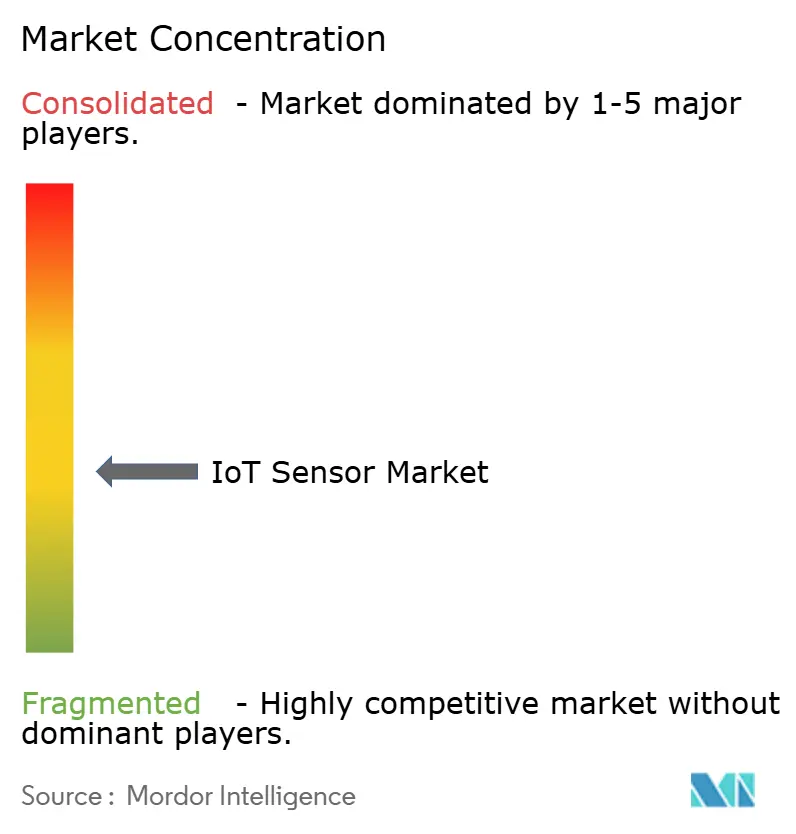
Recent Industry Developments
- June 2025: Infineon Technologies established a new SURF (Sensor Units & Radio Frequency) business unit to enhance sensor and RF capabilities, targeting the growing demand for IoT sensors driven by green energy, mobility, and IoT trends in a market projected to exceed USD 20 billion by 2027
- June 2025: Texas Instruments unveiled new automotive chips including the first high-speed, single-chip lidar laser driver and BAW-based clocks with 100 times more reliability than quartz-based alternatives, positioning the company to capture significant market share in the growing automotive semiconductor sector
- May 2025: STMicroelectronics announced mass production of turnkey Bluetooth/Wi-Fi modules developed in collaboration with Qualcomm, advancing smart sensor connectivity solutions for automotive and industrial applications
Global IoT Sensor Market Report Scope
Internet of things is a network of objects/devices primarily surrounded by sensors, network connectivity, and software to exchange and collect data. Their applications are found in multiple industries, such as healthcare, automotive, transportation, and manufacturing. IoT systems connect specialized devices designed for specific purposes with a limited degree of programmability and customizability. Moreover, IoT systems also store and process data in a distributed manner. The market study primarily comprises estimates derived for sensor types, such as pressure, temperature, chemical, motion/proximity, and similar types. Additionally, the geographical coverage provides the market number for the regions. The country-level data comprises qualitative trends to provide deep insights into the market trends in the region.
| Pressure Sensors |
| Temperature Sensors |
| Motion and Proximity Sensors |
| Chemical and Gas Sensors |
| Humidity Sensors |
| Image Sensors |
| Inertial Sensors (Accelerometer, Gyroscope) |
| Magnetic Sensors |
| Optical and Light Sensors |
| Level and Flow Sensors |
| MEMS |
| CMOS |
| Optical |
| Electrochemical |
| Magnetic |
| Piezoelectric and Others |
| Wired (Ethernet, Modbus, CAN) |
| Wireless WiFi |
| Wireless Bluetooth/BLE |
| Wireless Zigbee/Z-Wave |
| Wireless LoRaWAN/Sigfox |
| Wireless Cellular (2G, 5G, NB-IoT) |
| RFID/NFC |
| Battery-Powered |
| Energy-Harvesting (Thermal, Vibration, RF) |
| Powered-over-Ethernet and Wired Power |
| Manufacturing and Industrial Automation |
| Automotive and Transportation |
| Healthcare and Medical Devices |
| Consumer Electronics and Wearables |
| Smart Home and Building Automation |
| Energy and Utilities (Oil and Gas, Smart Grid) |
| Agriculture and Environmental Monitoring |
| Logistics and Supply Chain (Cold-chain, Asset Tracking) |
| Smart City Infrastructure |
| Defense and Security |
| Predictive Maintenance |
| Condition Monitoring |
| Structural Health Monitoring |
| Human-Machine Interface |
| Ambient Sensing |
| North America | United States |
| Canada | |
| Mexico | |
| South America | Brazil |
| Argentina | |
| Rest of South America | |
| Europe | Germany |
| United Kingdom | |
| France | |
| Italy | |
| Spain | |
| Nordics (Sweden, Norway, Denmark, Finland) | |
| Benelux (Belgium, Netherlands, Luxembourg) | |
| Middle East | Saudi Arabia |
| United Arab Emirates | |
| Israel | |
| Turkey | |
| Africa | South Africa |
| Nigeria | |
| Kenya | |
| Rest of Africa | |
| Asia | China |
| Japan | |
| India | |
| South Korea | |
| ASEAN (Singapore, Malaysia, Thailand, Indonesia, Philippines, Vietnam) |
| By Sensor Type | Pressure Sensors | |
| Temperature Sensors | ||
| Motion and Proximity Sensors | ||
| Chemical and Gas Sensors | ||
| Humidity Sensors | ||
| Image Sensors | ||
| Inertial Sensors (Accelerometer, Gyroscope) | ||
| Magnetic Sensors | ||
| Optical and Light Sensors | ||
| Level and Flow Sensors | ||
| By Technology | MEMS | |
| CMOS | ||
| Optical | ||
| Electrochemical | ||
| Magnetic | ||
| Piezoelectric and Others | ||
| By Connectivity | Wired (Ethernet, Modbus, CAN) | |
| Wireless WiFi | ||
| Wireless Bluetooth/BLE | ||
| Wireless Zigbee/Z-Wave | ||
| Wireless LoRaWAN/Sigfox | ||
| Wireless Cellular (2G, 5G, NB-IoT) | ||
| RFID/NFC | ||
| By Power Source | Battery-Powered | |
| Energy-Harvesting (Thermal, Vibration, RF) | ||
| Powered-over-Ethernet and Wired Power | ||
| By End-Use Industry | Manufacturing and Industrial Automation | |
| Automotive and Transportation | ||
| Healthcare and Medical Devices | ||
| Consumer Electronics and Wearables | ||
| Smart Home and Building Automation | ||
| Energy and Utilities (Oil and Gas, Smart Grid) | ||
| Agriculture and Environmental Monitoring | ||
| Logistics and Supply Chain (Cold-chain, Asset Tracking) | ||
| Smart City Infrastructure | ||
| Defense and Security | ||
| By Application (Deep-Dive) | Predictive Maintenance | |
| Condition Monitoring | ||
| Structural Health Monitoring | ||
| Human-Machine Interface | ||
| Ambient Sensing | ||
| By Geography | North America | United States |
| Canada | ||
| Mexico | ||
| South America | Brazil | |
| Argentina | ||
| Rest of South America | ||
| Europe | Germany | |
| United Kingdom | ||
| France | ||
| Italy | ||
| Spain | ||
| Nordics (Sweden, Norway, Denmark, Finland) | ||
| Benelux (Belgium, Netherlands, Luxembourg) | ||
| Middle East | Saudi Arabia | |
| United Arab Emirates | ||
| Israel | ||
| Turkey | ||
| Africa | South Africa | |
| Nigeria | ||
| Kenya | ||
| Rest of Africa | ||
| Asia | China | |
| Japan | ||
| India | ||
| South Korea | ||
| ASEAN (Singapore, Malaysia, Thailand, Indonesia, Philippines, Vietnam) | ||
Key Questions Answered in the Report
What is the current value of the smart sensors market?
The smart sensors market is valued at USD 42.21 billion in 2025 and is forecast to reach USD 116.21 billion by 2030.
Which region leads global demand for IoT sensors?
Asia-Pacific leads with 32.4% revenue, driven by China’s smart-manufacturing push and Japan’s private 5G factory networks.
Why are image sensors growing faster than other sensor types?
Autonomous vehicles and AI-based quality inspection systems require high-resolution, time-synchronized imaging, pushing image sensors at a 28.4% CAGR.
How does energy harvesting influence IoT sensor deployments?
Energy-harvesting designs eliminate battery maintenance, enabling remote monitoring in offshore wind farms and industrial equipment while growing 35.6% annually.
What are the major restraints to market growth?
Tight 200 mm MEMS-foundry capacity, calibration drift in chemical sensors, and cybersecurity risks in wireless networks temper overall CAGR by several percentage points.
Which companies are shaping competitive dynamics?
Bosch Sensortec, Honeywell, STMicroelectronics, Infineon, and Texas Instruments lead through AI-enabled sensors, strategic partnerships, and dedicated semiconductor fab projects.
Page last updated on:
